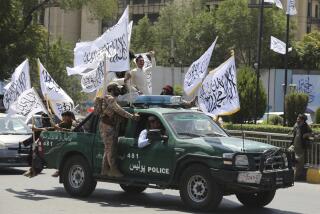Strict Taliban Dress Code Hems In Afghan Women
- Share via
KABUL, Afghanistan — When Rana, a former junior in English at Kabul University, first reluctantly donned a burka--the emblem of a woman’s place in the new Afghan order--her heart sank.
“I felt really bad,” said the 23-year-old Kabul resident. “Since the day the Taliban came, I have felt that I am a woman, and that I have no choice in my life.”
Ironically, the garment that has come to symbolize the fanatical Islam of the fundamentalist Taliban militia has no roots in this country and no links to the era or homeland of the Prophet Muhammad, the religion’s founder, scholars say.
The burka--called a chaudri by the Afghans--is a relatively recent import from the court of the Ottoman sultans in Constantinople, present-day Istanbul in Turkey.
“To protect women who worked in the palace of the Sublime Porte and show they were associated with the palace, the Ottomans originated the chaudri,” said G. M. Dareez, professor of law at Kabul University and a former Afghan minister of justice, who has written a treatise on the garment. “Other women saw their sisters wearing the chaudri were respected, and wanted one too.”
About two centuries ago, the burka made its way eastward from the Ottoman Empire to Afghanistan, perhaps in the baggage trains of Turkish military advisors and their wives, Dareez said. Afghan city women then adopted the flowing item of clothing to advertise their high status.
But with the emancipation of Afghan women during the 20th century, educated city dwellers shed their burkas, leaving the garment to poor women and villagers. In the rural areas inhabited by the Pushtun tribes of southern and eastern Afghanistan, which are home to most of the Taliban’s fighters and leaders, the burka became the most public sign of women’s traditionally subservient status.
“What the Taliban is doing is trying to impose Pushtun village values on all Afghanistan,” a U.N. official said.
For the uninitiated, a burka can feel claustrophobically confining, with only a narrow mesh-covered slit for the eyes that gives the wearer tunnel vision and requires her to tilt her head downward to see where she is putting her feet. In Afghanistan’s broiling summer heat, the garment quickly becomes a sweatbox, without even a hole to breathe through.
*
The first time she wore one, Rana said, she stumbled three times and almost fell. But under the Taliban, she said, she has little choice: She lives with her parents and six siblings, and her job with an international aid agency is the family’s sole source of income.
“They think it’s Islamic if they cover all the women,” Rana complained of the Talibs. “In fact, in the Koran, it says nothing about wearing burkas or men beating women [who do not wear them]”--which the Talibs have done.
Burka vendor Farid Sherzai, 27, has seen business increase 25% since the Taliban captured Kabul on Sept. 27 and began whipping women who left home without being completely covered.
“As far as business goes, since the coming of the Talibs, I’m happy,” Sherzai said.
More to Read
Sign up for Essential California
The most important California stories and recommendations in your inbox every morning.
You may occasionally receive promotional content from the Los Angeles Times.













